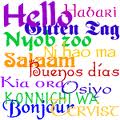Rewarding Careers: ESL Teacher

Language teaching offers opportunities for students and teachers to learn together.
The musical rhythms of Spanish dance alongside the sharp glides of Mandarin; bold sounding Arabic is heard not too far away either. This is the typical language classroom. The students are all new immigrants to Canada and are all beginning to find their voice in English. Some are doctors or engineers, others may be stay-at-home moms or recent refugees. Every class is always a little different and no lesson plan is ever identical.
According to the latest census results, Canada is currently seeing the highest levels of foreign-born individuals in 75 years. This means that one in five people are newcomers! Toronto, Vancouver and Montreal remains the favored cities for settlement, but other cities across Canada (Halifax, Edmonton, and Winnipeg) are seeing a drastic rise within the last decade as well. With over 70% of the foreign-born population speaking a language other than English or French, ESL is becoming a field of great demand.
A Typical Day
 Grammar lessons can’t be avoided, but it shouldn’t make up the entire class. There is great freedom for the teacher since the curriculum allows flexibility and creativity. In my class we may do an hour of grammar review followed by a class discussion about different cultural taboos or what the heck “double double” means. Students range in age from 18 to 60 and bring with them a lifetime of experiences to share. An Ethiopian student introduced me to delicious injera; a Vietnamese student wore a beautiful ao dai to show her classmates.
Grammar lessons can’t be avoided, but it shouldn’t make up the entire class. There is great freedom for the teacher since the curriculum allows flexibility and creativity. In my class we may do an hour of grammar review followed by a class discussion about different cultural taboos or what the heck “double double” means. Students range in age from 18 to 60 and bring with them a lifetime of experiences to share. An Ethiopian student introduced me to delicious injera; a Vietnamese student wore a beautiful ao dai to show her classmates.
Every autumn I prepare the students for their first Canadian winter and I always smile when I see how fascinated and delighted they are with the first snowfall. Being an ESL teacher really means becoming their first Canadian friend. It is my responsibility to help the students prepare for all the obstacles they didn’t expect. Finding a job means writing a resume and not submitting a picture with it (which is common practice in parts of Asia). Going onto higher education at a Canadian university or college means applying for student loans and bursaries, (which isn’t common practice in parts of Europe and the Middle East). Even everyday tasks like using the ATM or making an appointment can be daunting. My job is to make this a little easier.
How to Become an ESL Teacher
In order to teach ESL in Canada you need to apply and be certified with Teachers of English as a Second Language (TESL). To do this you first need to complete a one year Certificate to Teach English as a Second Language (CTESL) program at a recognized university or college. Part of the program will be theory, and the other part will be a practicum. It is entirely up to the student whether they want to teach (under the guidance of a teacher) during their practicum or simply observe. Every province has slightly different requirements (TESL Ontario requires 50 hours of teaching experience in British Columbia it’s 20), so be sure to check it carefully. The CTESL program will only accept students who hold a university degree (you don’t need to be an English major), but are also known to accommodate students with previous teaching and training experiences.
If you would rather teach children than adults, you won’t need a CTESL or be accredited with TESL. Instead, you would need to complete your Bachelor of Education with specific courses in ESL methodology. If you’re thinking of traveling outside of Canada to teach, a CTESL isn’t normally required overseas, but you can demand a higher salary because you have it. Not to mention that you’ll also be more prepared than those without.
A career as an ESL teacher is beyond rewarding from the difference you’re making in the students’ lives to the difference they are making in yours.





Laisser un commentaire!